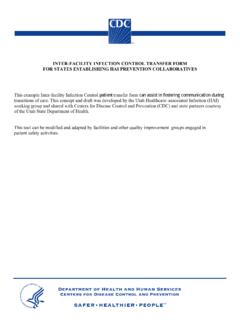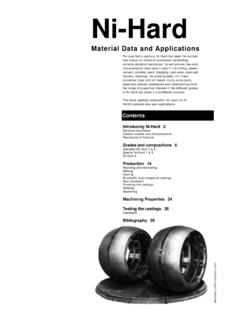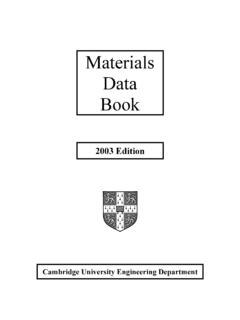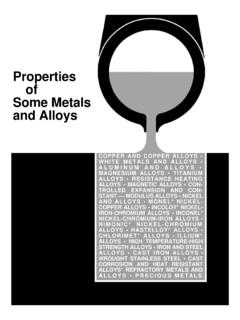Transcription of Damping Properties of Selected Steels and Cast Irons
1 IRIi906s1 PLEASE DO NOT REMOVE FRCM LIBRARY Bureau of Mines Report of Investigations/1987 Damping Properties of Selected Steels and cast Irons By A. Visnapuu, R. W. Nash, and P. C. Turner UNITED STATES DEPARTMENT OF THE INTERIOR Report of Investigations 9068 Damping Properties of Selected Steels and cast Irons By A. Visnapuu, R . W. Nash, and P. C. Turner UNITED STATES DEPARTMENT OF THE INTERIOR Donald Paul Hodel, Secretary BUREAU OF MINES Robert C. Horton, Director Library of Congress Cataloging in Publication Data: Visnapuu, A. (Aarne) Damping Properties of Selected Steels and cast Irons .
2 (Report of investigations; 9068) Bibliography: p. 14-15. Supt. of Docs. no.: I : 9068. 1. Mining machinery-Vibration. 2. Steel-Testing. 3. cast iron -Testing. 4. Damping (Mechanics). I. Nash, R. W. (Robert W.). II. Turner, P. C. Ill. Title. IV. Series: in-vestigations (United States. Bureau of Mines) ; 9068. [TN345] 622 s [ ] 86-600351 CONTENTS Abstract .. 0 I Introduction .. Previous investigations .. Purpose of this investigation .. Experimental procedure .. Results and discussion .. Steels .. cast Irons Conclusions.
3 References .. 1. 2. 3. 4. 5. 1. 2. ILLUSTRATIONS Microstructures of carbon and alloy Steels .. Specific Damping capacity of carbon and alloy Steels as a function of stress .. Microstructures of spheroidized heat-treated carbon and alloy Steels . Microstructures of cast lrons .. Specific Damping capacity of cast Irons as a function of stress Specific Specific Damping da,mping TABLES capacities and microstructures of and alloy Steels . capacities of spheroidized heat-treated carbon and alloy Steels .. 3. Specific Damping capacities and graphite morphologies of Selected cast Irons .
4 4. Composition and mechanical Properties of Selected cast Irons .. 1 2 2 3 3 4 4 10 14 14 5 7 8 11 13 7 9 10 10 t-UNIT OF MEASURE ABBREVIATIONS USED IL'l" THIS REPORT c degree Celsiu s Oe oersted C/h degree Celsius pe r hour pct percent h hour lb pound Hz hertz psi pound (force) per square inch in inch vol pet 'volume percent lb/min pound per minut e wt pet Feight percent min minute [)AMPING Properties OF Selected Steels AND cast Irons By A. Visnapuu,1 R. W. Nash,2 and P. C. Turner3 ABSTRACT Excessive noise and high vibration are inherently associated with equipment used in the mining, extraction, and processing of mineral resources.]
5 High vibration degrades structural components, often leading to catastrophic failure and loss of productivity, and excessive noise can result in permanent hearing loss. In order to foster efficient utilization of the Nation's mineral resources and minimize occupational hazards associated with mineral processing, the Bureau of Mines investigated the relationship between the microstructures of carbon and alloy Steels and cast Irons and their Damping capacities (ability to absorb vibration). Researchers measured Damping capacity and other Properties and investigated the effects of carburizing, spheroidizing, and annealing.
6 The investigators found that in carbon and alloy Steels , rounded colo-nies of fine-grained pearlite in a ferrite matrix correlate well with low Damping capacity. Steel microstructures that exhibit sharp-faceted pearlite in ferrite matrix and partially or fully spheroidized cementite in ferrite show considerably higher Damping . In cast Irons , the lowest Damping capacity is associated with nodular graphite microstructure, and the specific Damping capacity (SDC) increases as the graphite micro-structure progresses from nodular to compacted to flake. Predominant ferrite in cast Irons is also associated with good Damping .
7 SDC data are presented for Selected carbon and alloy Steels and cast Irons . 'Research physicist. 2physical science technician. 3 Metallurgist. Rolla Research Center, Bureau of , Rolla, MO. L 2 INTRODUCTION In recent years, the vibration Damping inherent in engineering materials has gained importance as a design considera-tion, in addition to the more commonly considered mechanical Properties such as tensile and yield strength, ductility~ , and. toughness. -The need for improved Damping Properties , without undue sacrifice of other Properties that determine durability, is the result of increased demand for lower product, work-place, and environmental noise, and the realization that reduced vibration can proloM the service life of machinery and equipment.
8 One fundamental way to im-prove Damping Properties is to use rel-atively high- Damping materlalS:-erf the available structural alloy systems, only ferrous alloys appear to be cheap enough in intrinsic material and processing cost to be economically feasible. PREVIOUS INVESTIGATIONS Previous investigations have developed a variety of Damping materials an methods, and some have been developed to the point of commercial availability. Manganese-copper binary alloys ranging from 50 to 80 wt pct Mn, both cast (1)4 and powder-metallurgy consolidated (I), exhibit SDC's in the range 20 to 25 pct at a stress of 5,000 psi.
9 In addition to high Damping capacity, these alloys have useful mechanical Properties comparable to those of mild steel. High Damping is obtained by solution heat treatment fol-lowed by aging to precipitate an inter-metallic phase. Other Mn-Cu-based Damping alloys with minor metal additions have been devel-oped. Sonoston5 alloy has the composi-tion Cu-54 Al-3 Ni (1). The Damping alloys Incramute I and II, developed by the International Copper 4 Underlined numbers in parentheses re-fer to in the list of references at the end of this report. 5 Reference to specific products does not imply endorsement by the Bureau of Mines.
10 Research Association, consist of Cu-40 Mn-2 Al and Cu-40 Mn-2 Al-2 Sn, respec-tively (i-i) 0 They are commercially available. While the Mn- Cu alloys possess excel,,, lent vibration Damping and good mechani-cal Properties , they have some disadvan-tages: (1) The cost of compo_n,ent e_tals and fabrication is high, and (2) Damping capacity decreases with temperature. Other low-strength materials are adequate for many applications. The Sonoston and Incramute I alloys lose their Damping above 750 C. Damping in Incramute II disappears above about 1250 C. The higher Damping transition temperature for Incramute II is due to the tin addi-tion, which apparently affects precipi-tate stability (i).














